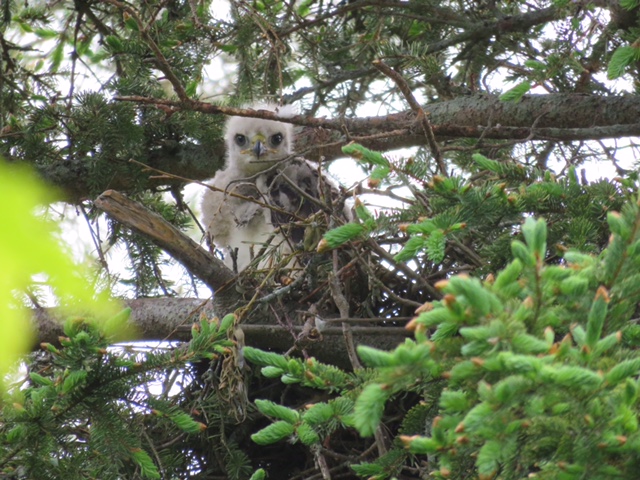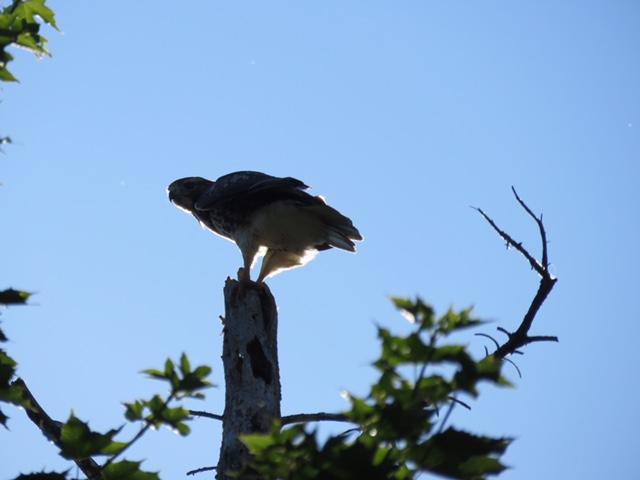Horse & Pony Aug-Oct 2016
/Learning to fly
I spent the last few months on baby watch.
In March, a pair of Red-tailed hawks set to work raising a family in a tall spruce tree on our lawn. Through rain, snow, and heavy wind they worked away – first building the nest, and then taking turns sitting on their precious eggs. I often caught sight of mom flying out, and dad stepping in to keep the eggs warm. Our lane is a wind tunnel – a precarious place for fragile eggs and tiny babies. Many mornings I woke after an especially stormy night fearful the nest would be on the ground. Finally near the end of May, one fluffy white baby appeared teetering near the edge of the nest. They did it!
On roughly the same timeline my daughter and her husband were nearing the end of construction of their new home before their baby arrived. The final months (with him working away like so many Maritimers) were a flurry of final decisions, and trips between building and baby supply stores, all squeezed in around work hours. Baby Levi arrived safe and sound one week early, and four days after they moved in.
As I write this, the young hawk is now as big as her mom and is on the move. She’s not always making the best decisions on where to perch around the farm. And she’s hungry. She hasn’t mastered hunting and spends much of her day crying to mom and dad to bring food. They do, but I wonder for how long and if she will master the skills she needs to survive? Little Levi on the other hand doesn’t have many worries at the moment.
The Youth Issue is a first for HP. It’s full of stories about young people and by young people – traveling, organizing, competing, selling, making, and generally just growing in every sense of the word – with horses as the catalyst (or perhaps more fittingly, the fertilizer). Of course we could have just as easily called this the Parenting Issue. Behind every one of these great kids is a sometimes bewildered, and often worn out, parent (or someone just as special) standing in the shadows – making lunches, hauling trailers, scrubbing manure stains, wiping boots, all while holding their cheque book and sometimes their breath.
Features writer Judith Scrimger spoke with many young people when preparing stories for this issue. “It is awe inspiring to see how these kids love and care for their horses. They are mature in their thinking, articulate, and thoughtful.” All of this was confirmed by the 12 wonderful submissions received for the Bits N’ Bridles Essay Contest. Choosing just one essay was an impossible task for the panel of judges so we narrowed it down to three. You can read about the much loved Digby, Amigo, and Harley on page 28-29. We also invited 4-H photography members to submit photos they had made for consideration as the cover. Cover photos are tricky. The files must be large and the subject must work within the parameters of the existing layout. Erica Sullivan of the Newport 4-H Club in Nova Scotia met all of the requirements with her photo of fellow member, Ella, Lentz, and her mare, Sox.
HP is happy to welcome new N.S. Report correspondent Teresa Alexander-Arab. The four provincial reports outline what has been a busy spring and summer in our region. Also in this issue Dr. Helen Douglas shares what we need to know to about the equine eye in Vets View, and Jana Hemphill talks to Mental Performance Consultant, Tara Costello, of Springvale, Prince Edward Island, on mental training for better performance, and the role of parents and coaches in attaining it. The annual Buy Local publication rounds out this August to October issue.
Enjoy the Youth Issue and the rest of the summer. If you have had a hand in developing a young horse person, give yourself a pat on the back. As Judith summed it up, “Horses are good for kids.”
I’m off to the barn with my daughter and grandson. How lucky am I?
It's been a treat to watch and listen to this baby (correctly called an eyeass) grow into adulthood. It happened fast – the photo above left was taken on June 3 and the photo above right was taken July 14. Red-tailed females are generally 30 percent larger than males. The size of this youngster leads us to believe she is female. Hawks are friends to farmers and horse owners, by keeping the mouse population under control. I hope the housing conditions were satisfactory and they come back to nest again next year. (Lisa Hines and Fran Coombes photos)



















